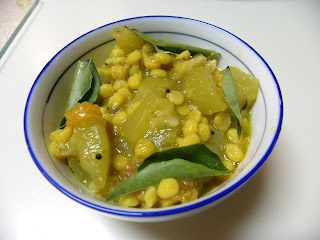|
Opo Squash with Bengal Gram Dal
|
Opo Squash is famously known as Lauki or Dudhi. Bengal Gram Dal is known as Channa Dal. This vegetable subji is often cooked at my home for dinner. In Ayurveda, Opo Squash is at the top of the list of vegetables for our body’s health. As you know, Bengal Gram Dal is also highly recommended to be used as a sugar stabilizer. Here is a quick recipe that is Jain, Vegan, and low in sugar.
Preparation Time: 20 Minutes
Recipe Type: Jain, Vegan, Low Sugar
|
Bengal Gram Dal
|
Ingredients:
| 1 | Opo Squash, peeled and cut into cubes = almost two cups | |
| 1 | Cup | Bengal Gram Dal, washed & soaked for 2 hours |
| 1 | Medium | Tomato, chopped |
| 1 | Green Chili | |
| 1 | Tsp | Grated Ginger |
| Curry Leaves (optional) | ||
| Cilantro, chopped for garnish | ||
| Salt to taste | ||
| 2 | TBsp | Oil |
| 1/4 | Tsp | Chili Powder |
| 1 | Tsp | Coriander Powder |
| 1 | Tsp | Cumin Powder |
| 2-3 | Small | Cinnamon Sticks |
| 2-3 | Cloves | |
| 1/4 | Tsp | Mustard Seeds |
| 1/4 | Tsp | Cumin Seeds |
| 1/4 | Tsp | Sugar |
| 1/2 | Tsp | Lemon Juice |
Directions:
- In a pan on medium, heat the oil.
- Add cinnamon, cloves, mustard seeds and cumin seeds.
- Once they start popping, add cut Opo Squash and Bengal Dal.
- Add 1 cup of water to cook and bring to a boil.
- Once it starts bubbling, add all of the spices and stir.
- Cover and reduce the heat.
- It will take almost 5-7 minutes to cook.
- Occasionally stir and cover so that the steam helps it cook.
- Check with your fingers by taking out few begal gram dal and pinching them to see if they are cooked.
- Opo squash should change color as it cooks.
Tips:
- Garnish with chopped cilantro.
- Serve with rice and Chappati.
- Gujarati Kadhi made with buttermilk can be served with this as it compliments the gram dal very well.
Serving is 1/6 of Recipe.
Let me know what you think by leaving a comment!
I love to hear from my readers!
Join my Newsletter here & be entered to win
“The Indian Slow Cooker”
The Health Benefits of Squash
The winter squash group includes pumpkin, acorn, butternut, and spaghetti squash. Winter squash, like other richly colored vegetables, provide an excellent source of carotenes. Generally, the richer the color, the richer the concentration. They also offer a very good source of vitamins B1 and C, folic acid, pantothenic acid, fiber, and potassium. Winter squash are also a good source of vitamin B6 and niacin.
Studies have shown that, due to their carotene properties, winter squash exert a protective effect against many cancers, particularly lung cancer. Diets that are rich in carotenes (especially pumpkins) offer protection against cancer, heart disease, and type 2 diabetes. Studies have also shown that pumpkin seeds are helpful in reducing symptoms of benign prostatic hyperplasia (BPH).
Since summer squash have a high water content, they are not as nutrient-dense as the winter varieties. Summer squash still provide several nutritional benefits. They are low in calories and provide a decent amount of vitamin C, potassium, and carotenes.
Studies have shown that juice made from summer squash is equal to juice made from pumpkins, leeks, and radishes in their ability to prevent cell mutations. Summersquash are especially beneficial during the summer months due to their higher water content. They protect against dehydration and the carotenes help to protect against the damaging effects of the sun.



